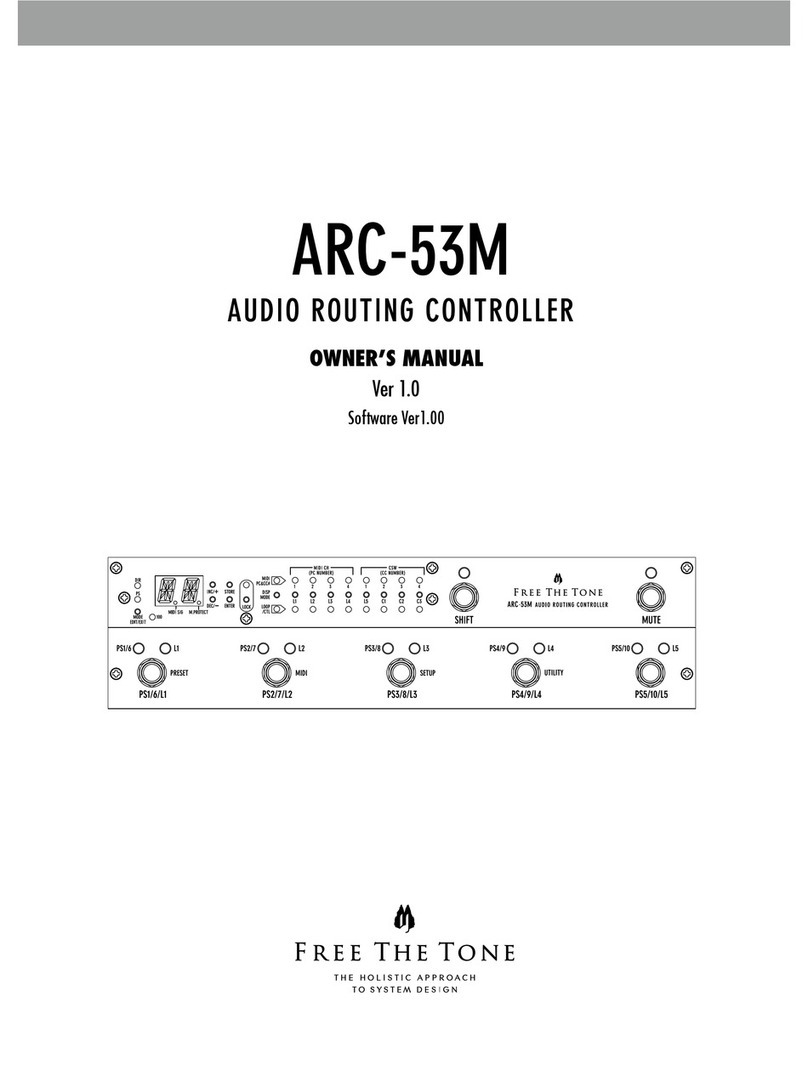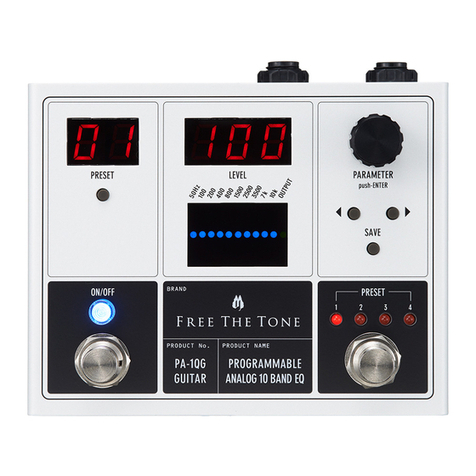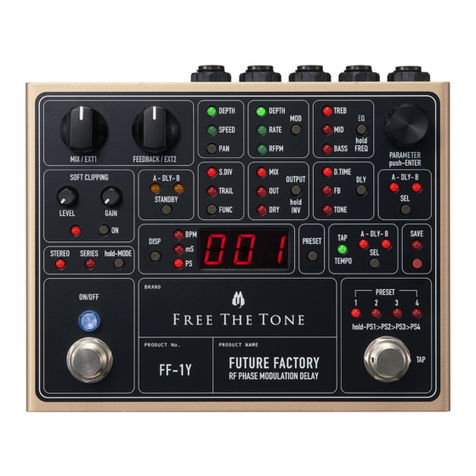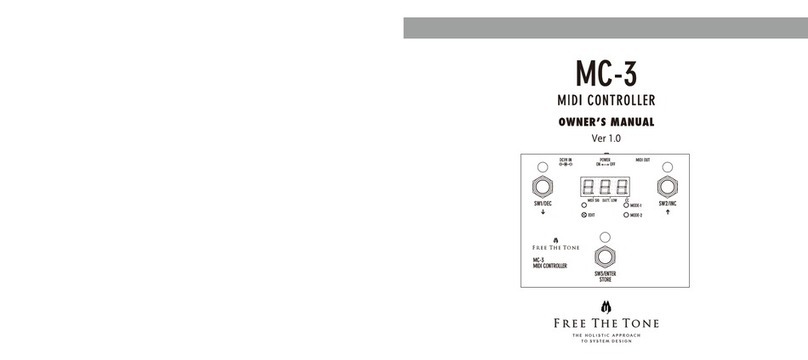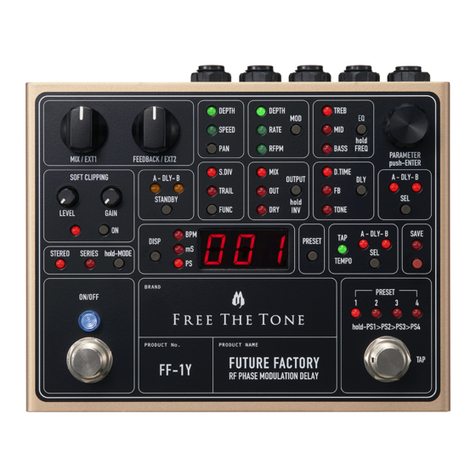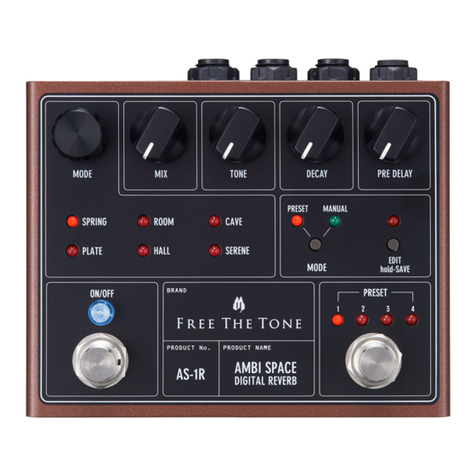10 11
Product Specifications
120 (15.5) 43
95 (7.3)
DC9V IN
OUT MIDI OUT/THRUMIDI IN
IN
INST LINE
INPUT LEVEL
721A001
• Number of presets: 99
• Input impedance: INST min. 1 MΩ/ LINE min. 300 kΩ
• Output load impedance: min. 10 kΩ
• Max. input level: INST +4 dBm / LINE +14 dBm (EQ setting = flat)
• Controls: cursor keys, PARAMETER encoder, INST(-10dB)/LINE(+4dB) level selector switch
• Frequencies
PA-1QG: 50 Hz, 100 Hz, 200 Hz, 400 Hz, 800 Hz, 1500 Hz, 2500 Hz, 3500 Hz, 7 kHz, 10 kHz (±12 dB)
PA-1QB: 40 Hz, 80 Hz, 125 Hz, 250 Hz, 500 Hz, 800 Hz, 1200 Hz, 2400 Hz, 4500 Hz, 8 kHz (±12 dB)
• Terminals: 1/4" standard phone jack x 2 (input and output) DC9V input jack (for AC adapter), DIN 5-pin connector x 2
(MIDI IN and OUT/THRU)
• Power supply: Dedicated DC9V AC adapter
• Current consumption: max. 200 mA
• Dimensions (W x D x H): 120 x 102.3 x 58.5 mm or 4.7 x 4.0 x 2.3 inches (incl. protuberances such as footswitch,
jacks, etc.)
• Weight (excl. accessories): approx. 350 g or 0.77 lbs
• Accessories: Warranty card, manual, AC adapter, rubber feet x 4
Specifications and appearance subject to change without notice.
Caution
Do not use or store the unit in environments where it
will be exposed to:
Extreme temperatures (direct rays of the sun, heat
sources such as radiators or stoves.)
High humidity or moisture.
Excessive dust or sand.
Excessive vibration or shock.
Whenever leaving the unit unattended for long
periods, be sure to unplug the AC adapter from the
power source to avoid creating a fire hazard.
Take care not to drop the unit, and do not subject it
to excessive pressure or weight.
Do not press the switches on the unit with a bare
foot, or unexpected injury may result.
Do not use solvents (such as benzine, paint thinner)
on the unit, since these may dull the finish or damage
the surface.
Warning
Never try to disassemble, or modify the unit.
Stop using the unit if you notice smoke or a strange odor
coming from it and unplug the AC adapter from the outlet.
Never try to repair the unit or replace parts unless so
instructed by the user’s manual. For other repair or parts
replacement contact your local dealer or Free The Tone.
Never unplug the AC adapter while your hands are wet.
Do not apply too much pressure or tension or place
a heavy object on the power cord. Doing so may
damage the power cord and create a danger of fire
or electrical shock.
Turn off the unit and unplug the AC adapter from the
outlet and contact your local dealer or Free The Tone
for repair in the case of any of the following:
The power cord is damaged.
Foreign objects (coins, pins, etc.) or liquid enter the unit.
The unit gets wet from rain or other liquid.
The unit is out of order.
Be careful of heat radiation from the unit.
Never cover the AC adapter with cloth or other objects.
Built-up heat can deform the case or cause a fire hazard.
SAFETY PRECAUTIONS
Precautions are identified by the two types of symbols below:
Caution
This symbol indicates that a risk of serious personal injury
or material damage may result if precautions are ignored.
Warning
This symbol indicates that a risk of death or serious
personal injury may result if precautions are ignored.
Be sure to read these precautions and the user’s manual before using this product.
Support/Service
Contact the following for support and/or repair service.
e-mail address: overseas@freethetone.com
